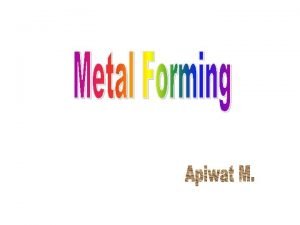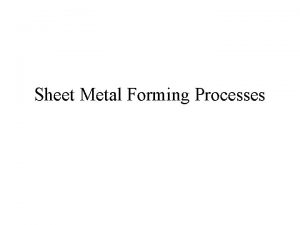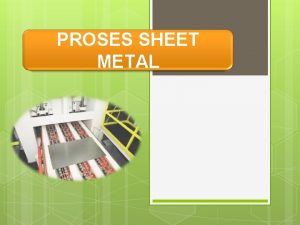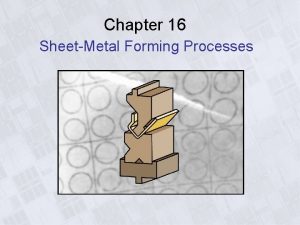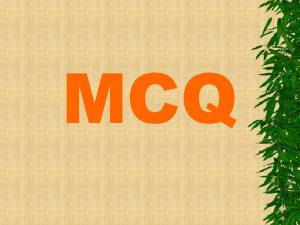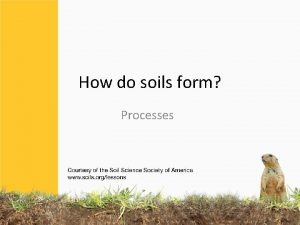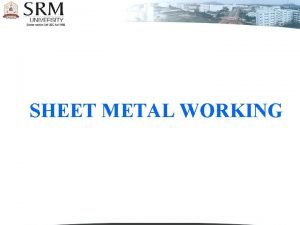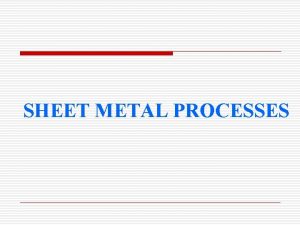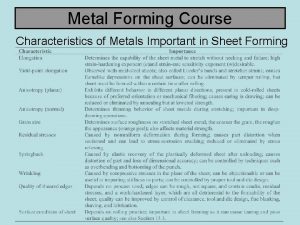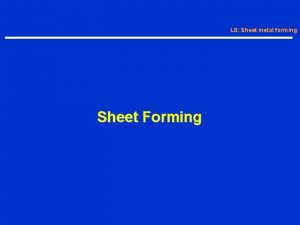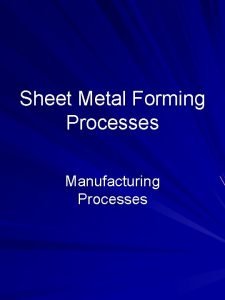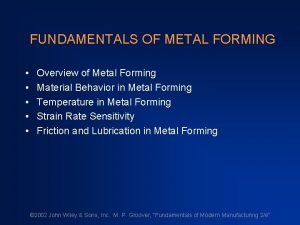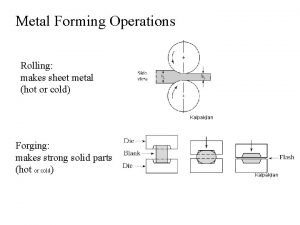Sheet Metal Forming Processes Introduction Ratio Surface Area











- Slides: 11

Sheet Metal Forming Processes

Introduction • Ratio – Surface Area: Volume is very high for sheet metal process. • Plates – thickness > 0. 25 inches – Boilers, bridges, ships, etc. use relatively thick plates • Usually sheet forming is done on relatively thin material. • Shapes can be of various size – Beverage can, car body • Sheet metal forming includes many widely used processes.

• Sheet Metal Characteristics • Formability • Methods – Sheet metal is formed as coils of sheets (by rolling) or plates. – Blanks are created for required shapes. • Shearing – sheets • Flame cutting - plates

Sheet Metal Characteristics • Main forces acting in sheet metal forming – tensile • No (or very low) compressive load. Can lead to buckling or folding and wrinkling. • What is the big difference between bulk deformation and sheet metal? • What factors affect stretching and bending? • Elongation, Yield point elongation, anisotropy, grain size, residual stresses, springback, wrinkling.

Elongation • • • Uniform elongation region Postuniform elongation region True stress, true strain: Necking begins at Uniform strain hardening index ‘n’ Large ‘n’, uniform elongation is better.


• Necking occurs at an angle ‘ ’ – Localized – Diffuse • Depends on strain rate sensitivity ‘m’ of the material. • Postuniform elongation is higher with higher values of ‘m. ’ • Total elongation ‘n’ and ‘m. ’


Yield Point Elongation • • • Low carbon steel Certain points elongate more in the specimen. Strain rate elongation Grain size Y. P. elongation Leuder’s bands = stretcher strain marks – May not be acceptable in many cases – To avoid: “skin rolling” (cold rolling) – Reduces thickness of sheet 0. 5 to 1. 5 % • Strain aging can cuase the Y. P elongation to appear after a few days.

• Residual Stresses – Because of non uniform deformation. Cause distortion if some parts are removed. – Stress corrosion cracking • Springback – Thin – considerable springback • Wrinkles – Due to compressive load in certain areas.

• Anisotropy – Previous history of the sheet metal can cause anisotropy. – Crystallographic – grain orientation – Mechanical Fibering - alignment of impurities, inclusions • Grain Size – Mechanical properties – Appearance: coarse grain causes rough surface appearance (orange peel)
 Fundamentals of metal forming
Fundamentals of metal forming Area of sheet metal
Area of sheet metal Apa itu metal forming
Apa itu metal forming Forming process in sheet metal
Forming process in sheet metal Mcq on sheet metal forming
Mcq on sheet metal forming Lateral surface area means
Lateral surface area means Curved surface area and total surface area of cone
Curved surface area and total surface area of cone 4 soil forming processes
4 soil forming processes Introduction of sheet metal
Introduction of sheet metal Introduction of sheet metal
Introduction of sheet metal Cold working vs hot working
Cold working vs hot working Fine blanking
Fine blanking
